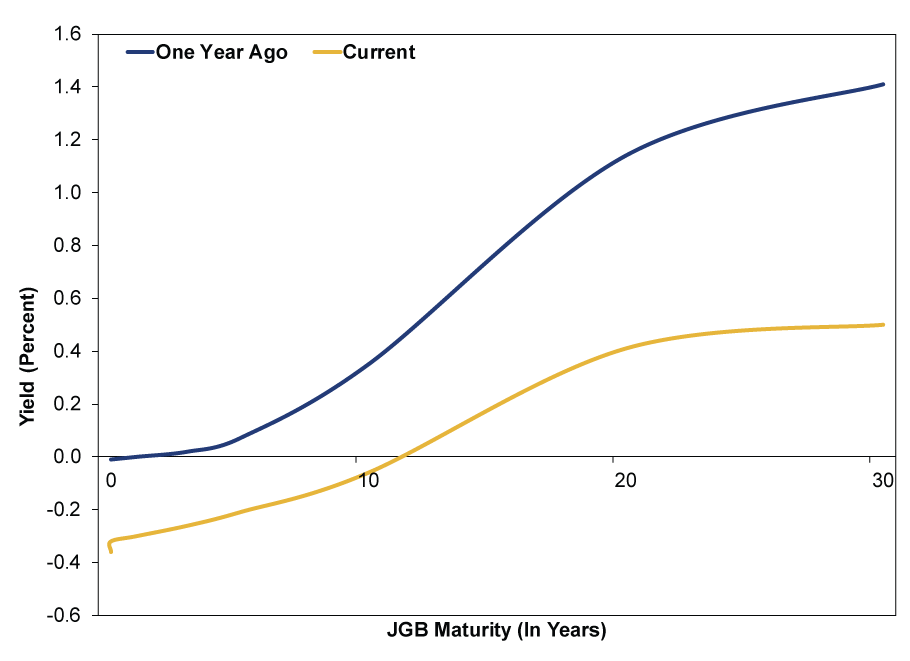Personal Wealth Management / Market Analysis
Bank of Japan Beefs Up Policy With Three More Letters
The Bank of Japan's latest monetary gimmick doesn't change much.
The BoJ threw some extra letters at Japan's stagnant economy Wednesday, tweaking its quantitative easing program after the bank's "Comprehensive Assessment of Monetary Policy" identified the flattening yield curve, which is crimping banking profitability, as the primary negative resulting from its policy decisions. Officials made no changes to short-term negative interest rates (-0.1%) or planned asset purchases (¥80 trillion in Japanese Government Bonds, aka JGBs; ¥6 trillion in equity ETFs; ¥90 billion in REITs). However, they set a new interest rate target of 0% for 10-year JGB yields-an effort to steepen the yield curve. The BoJ's standing program is now called "Quantitative and Qualitative Monetary Easing With Yield Curve Control," or if you prefer, QQEYCC. The media flipped for it, but the YCC addition doesn't much change the calculus, as even success would ensure the yield curve remains very flat.
The BoJ called for the "Comprehensive Assessment" to examine why monetary policy has failed to stoke economic activity and reach a 2% inflation target, despite Japan's being four years into one of the largest QE programs ever attempted. The bank also sought to examine both the positive and negative effects of its policy decisions, with intent to tweak future policy to mitigate the negatives.
The BoJ's chief finding about QE isn't surprising, though it is noteworthy that this is the first central bank to publicly acknowledge it. As we've repeatedly pointed out over the years, any benefits from QE (lower borrowing costs for households and businesses) are overshadowed by the flatter yield curve, which compresses banks' profit margins and thus discourages lending. Negative interest rates on excess reserves, implemented in Japan in January, aimed to coax lending but instead made the yield curve even flatter, as they fueled demand for higher-yielding, longer-dated assets. This made life even more painful for Japanese Financials, which have complained bitterly about reduced profitability.
Yet for all the rhetoric, the bank's policy tweaks won't really change or fix anything-it's mainly lip service to banks. The BoJ won't purchase fewer bonds. It's just altering the type and pace of bond purchases. The bank will no longer buy JGBs in the 7-12 year maturity range, in theory reducing downward pressure on 10-year yields (which yielded around -0.3% before the meeting). Instead, the BoJ will target shorter duration bonds, while the Ministry of Finance issues more longer dated bonds in an effort to increase supply, driving prices down and yields higher.
The bank expects this one-two punch to steepen the yield curve and improve Financials' profitability. In reality, however, it probably won't accomplish much. As Exhibit 1 shows, Japan's yield curve has flattened significantly over the last year, and bringing 10-year yields up to 0% (presuming the program works as intended) won't move the needle.
Exhibit 1: Japan's Flattening Yield Curve
Source: FactSet, as of 9/21/2016. Japanese yield curve on 9/20/2015 and 9/20/2016.
Today's assessment was never going to resemble an admission of defeat or policy failure by the BoJ. This central bank, like so many others, seems never to identify a problem with the prescription-just the dosage. If it isn't working, just do more of it or do it in a slightly different way. If you can't reach your inflation target, just blame "inflation expectations" for holding prices down, scrap the target and make an "inflation-overshooting commitment" to maintain accommodative policy until inflation exceeds 2% for an extended period-all of which the BoJ did today.
The irony is the bank is scrambling to solve self-inflicted problems. Japan's struggle to break out of deflation isn't a result of mass psychology. Inflation is always and everywhere a monetary phenomenon, not a psychological one. The primary culprit is the flat yield curve, which dampens lending and money supply growth. Trying to steepen a yield curve that the bank itself flattened is the epitome of chasing your own tail. The bank's confused, misguided policy remains a primary reason we think investors' best opportunities lie outside Japan.
If you would like to contact the editors responsible for this article, please message MarketMinder directly.
*The content contained in this article represents only the opinions and viewpoints of the Fisher Investments editorial staff.
Get a weekly roundup of our market insights
Sign up for our weekly e-mail newsletter.

You Imagine Your Future. We Help You Get There.
Are you ready to start your journey to a better financial future?

Where Might the Market Go Next?
Confidently tackle the market’s ups and downs with independent research and analysis that tells you where we think stocks are headed—and why.





